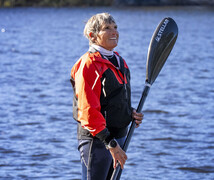Children with scoliosis require frequent X-rays to check their progress and monitor their growth. Over time, that can mean a lot of exposure to radiation. Fortunately, a unique imaging technology called EOS is available at several Duke Health locations. It significantly reduces that radiation exposure and provides the high-quality images doctors need to diagnose and treat scoliosis and other musculoskeletal conditions in children.
The Cumulative Effect of X-Rays
Children with scoliosis undergo multiple X-rays to diagnose and monitor their condition. In most cases, they require at least two X-rays every year to assess their spine curvature as they grow. If they’re a fast grower or underwent surgery, they could require four or more per year, said Duke pediatric orthopaedic surgeon Robert Lark, MD.
That can be concerning because the low doses of radiation from X-ray exposure accumulate over a lifetime. Research suggests the radiation exposure can increase the risk of cancer, especially thyroid, endometrial, and breast cancer, in people with scoliosis. “Anything we can do to minimize radiation exposure for a child is huge,” said Dr. Lark.
Significantly Less Radiation Than Traditional X-Rays
With this concern in mind, in 2016, Duke Health became the first center in North Carolina to acquire an EOS system. This technology reduces radiation exposure by 50% to 85% compared with traditional X-rays, which goes a long way toward reducing a person’s lifetime exposure. A scoliosis X-ray requires two images, one taken from the front and one from the side. EOS captures the two views simultaneously, which means fewer scans per visit. Today Duke owns three of the seven EOS systems in the state.
EOS Creates Cleaner Images
According to Dr. Lark, EOS also produces better images. “With EOS we can take one clear image while the patient is standing, which shows what the spine looks like under weight-bearing conditions.” That’s an advantage over traditional X-rays, which create multiple smaller images that must be stitched together. This creates a seam between images, which disrupts the doctor’s view.
Adults with Orthopaedic Conditions Also Benefit from EOS
Adults and children with other spine, knee, and hip conditions also benefit from EOS, especially if they require multiple scans. EOS images can also be used to create a 3D model like a CT scan does, but with 95% less radiation. If a full-body image is not necessary -- for a knee condition, for example -- the EOS system can be set to scan just that area, reducing the radiation exposure even more.
Duke Is Committed to Patient Safety
“It’s important for people to realize that EOS is available at Duke,” said Dr. Lark. “Patient safety is the number one reason we made the significant investment to acquire this technology.”





